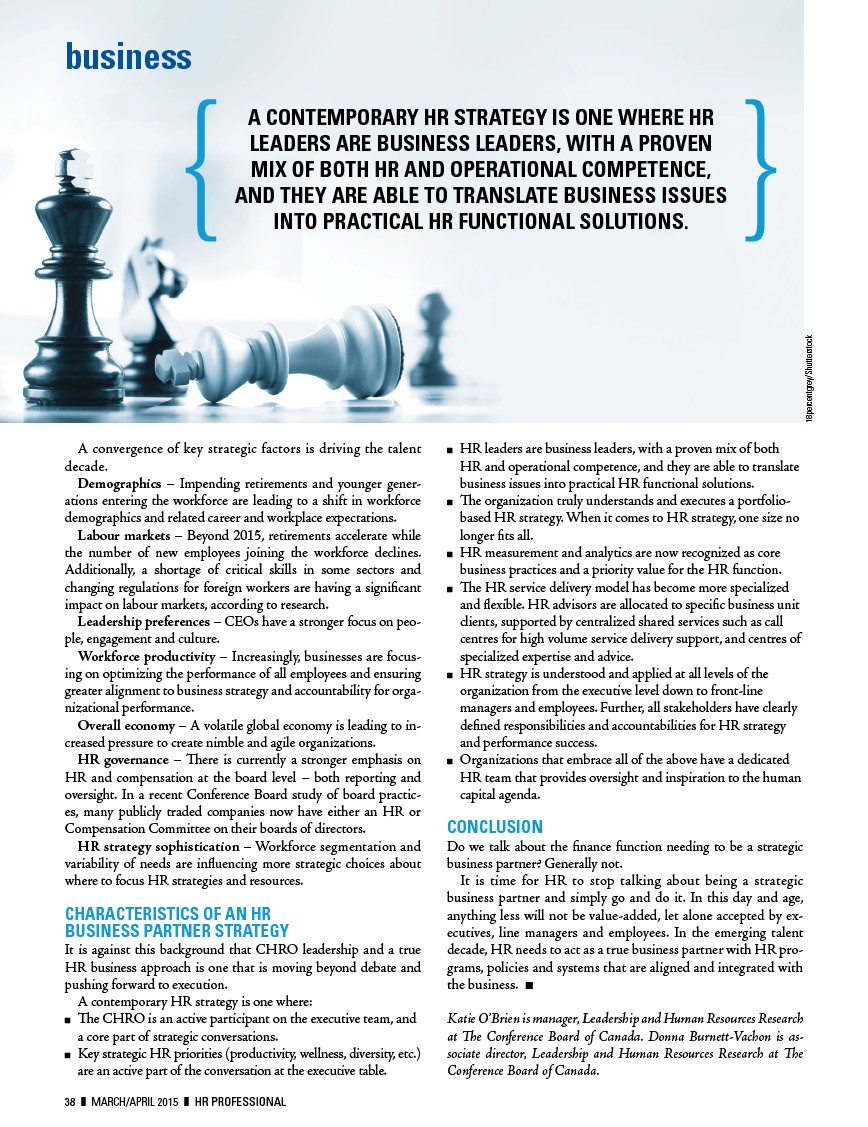
A convergence of key strategic factors is driving the talent
decade.
Demographics – Impending retirements and younger generations
entering the workforce are leading to a shift in workforce
demographics and related career and workplace expectations.
Labour markets – Beyond 2015, retirements accelerate while
the number of new employees joining the workforce declines.
Additionally, a shortage of critical skills in some sectors and
changing regulations for foreign workers are having a significant
impact on labour markets, according to research.
Leadership preferences – CEOs have a stronger focus on people,
engagement and culture.
Workforce productivity – Increasingly, businesses are focusing
on optimizing the performance of all employees and ensuring
greater alignment to business strategy and accountability for organizational
performance.
Overall economy – A volatile global economy is leading to increased
pressure to create nimble and agile organizations.
HR governance – There is currently a stronger emphasis on
HR and compensation at the board level – both reporting and
oversight. In a recent Conference Board study of board practices,
many publicly traded companies now have either an HR or
Compensation Committee on their boards of directors.
HR strategy sophistication – Workforce segmentation and
variability of needs are influencing more strategic choices about
where to focus HR strategies and resources.
CHARACTERISTICS OF AN HR
BUSINESS PARTNER STRATEGY
It is against this background that CHRO leadership and a true
HR business approach is one that is moving beyond debate and
pushing forward to execution.
A contemporary HR strategy is one where:
■■ The CHRO is an active participant on the executive team, and
a core part of strategic conversations.
■■ Key strategic HR priorities (productivity, wellness, diversity, etc.)
are an active part of the conversation at the executive table.
■■ HR leaders are business leaders, with a proven mix of both
HR and operational competence, and they are able to translate
business issues into practical HR functional solutions.
■■ The organization truly understands and executes a portfoliobased
HR strategy. When it comes to HR strategy, one size no
longer fits all.
■■ HR measurement and analytics are now recognized as core
business practices and a priority value for the HR function.
■■ The HR service delivery model has become more specialized
and flexible. HR advisors are allocated to specific business unit
clients, supported by centralized shared services such as call
centres for high volume service delivery support, and centres of
specialized expertise and advice.
■■ HR strategy is understood and applied at all levels of the
organization from the executive level down to front-line
managers and employees. Further, all stakeholders have clearly
defined responsibilities and accountabilities for HR strategy
and performance success.
■■ Organizations that embrace all of the above have a dedicated
HR team that provides oversight and inspiration to the human
capital agenda.
CONCLUSION
Do we talk about the finance function needing to be a strategic
business partner? Generally not.
It is time for HR to stop talking about being a strategic
business partner and simply go and do it. In this day and age,
anything less will not be value-added, let alone accepted by executives,
line managers and employees. In the emerging talent
decade, HR needs to act as a true business partner with HR programs,
policies and systems that are aligned and integrated with
the business. ■
Katie O’Brien is manager, Leadership and Human Resources Research
at The Conference Board of Canada. Donna Burnett-Vachon is associate
director, Leadership and Human Resources Research at The
Conference Board of Canada.
business
18percentgrey/Shutterstock
A CONTEMPORARY HR STRATEGY IS ONE WHERE HR
LEADERS ARE BUSINESS LEADERS, WITH A PROVEN
MIX OF BOTH HR AND OPERATIONAL COMPETENCE,
AND THEY ARE ABLE TO TRANSLATE BUSINESS ISSUES
INTO PRACTICAL HR FUNCTIONAL SOLUTIONS.
38 ❚ MARCH/APRIL 2015 ❚ HR PROFESSIONAL